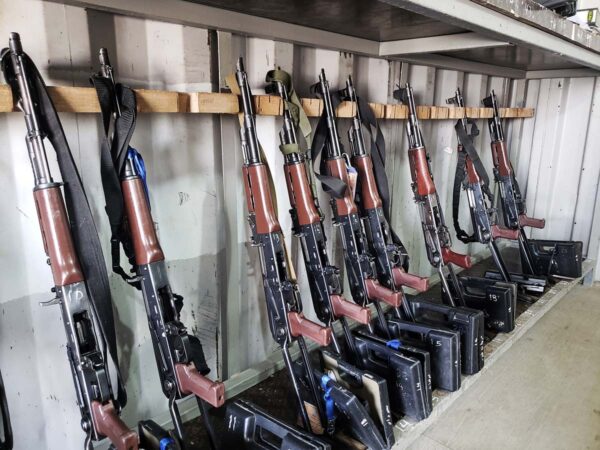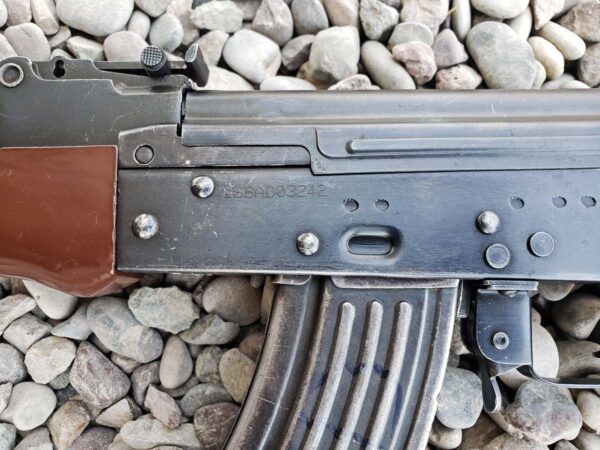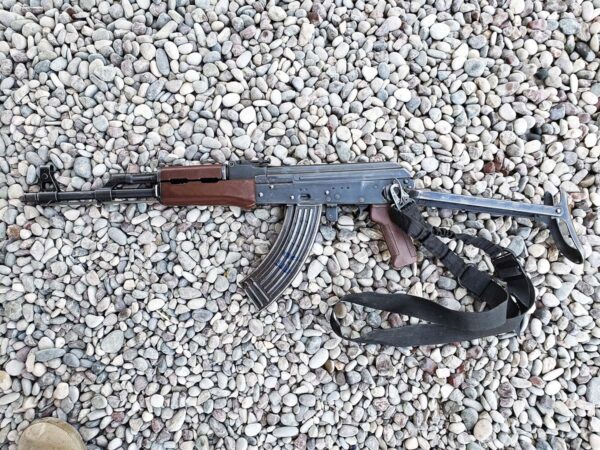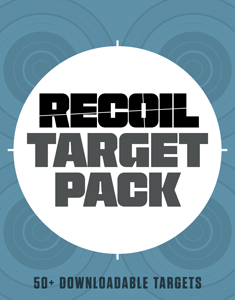The international arms trade is full of intrigue. There are books and films, invariably highlighting the sexier parts of the subject while minimizing the mundane. All international trade is an extension of politics, and double so when we’re talking about outfitting nations and secretly arming insurgents.
Nation-states expand their influence by supplying small arms to their partners, and most of the time, you could easily figure out a country’s political affiliations by just looking at their weapon fleet. During the Cold War years, a nation with a sudden influx of AKs and other Soviet armaments usually meant that the leaders of that state suddenly became enthusiastic about communist ideals — or at least pretended to.
To boost exports, many countries strived for brand recognition and put distinctive markings on their guns: “Made in West Germany,” “Made in the USA,” or at least factory logos and markings in their native language.
But there are always international actors who try to hide their arms proliferation and influence. There are many ways to do this. Arms can be procured and traded from third-party sources. Some obscure their own nation of origin by sanitizing serial numbers or even engraving their own counterfeit markings and making complete counterfeit weapons. Today, when we’re talking about counterfeit guns made for secret proliferation, one of the most prominent players and purveyors in this arena is Iran.
FIRST SIGHTS
By their nature, borders are where smuggling occurs, and small towns near them are stops along the rat trail. I first came across Iranian AKs in a small Iraqi town close to the Iraq-Iran border, in a place that looks exactly like the location of more-recent Mad Max movies. A desert wasteland bereft of beauty. And when you drive around, you always get text messages like “Welcome to Iran” on your phone — because you’re so close to the border that your SIM card is picking up Iranian cell towers instead of Iraqi ones.

There, I spent weeks inspecting a large armory full of different AKs: East German, Romanian, Yugoslavian, and Iraqi.
But at the very end of the inspection, I came across two Chinese AKs that just felt off. They were of questionable quality, had poor fit and finish, headspace was out of whack, and there was a weird serial number — no factory logo, just some seven-digit number starting with “8.” Initially, I thought those were just some very strange Chinese AKs. They did, however, have the standard “L” and “D” Chinese markings on the selector.

Long after I left that border town, those two oddball guns stuck in my memory, and sometime later, I recognized the style of serial numbers in the declassified National Ground Intelligence Center report called “Identifying Small Arms and RPGs Produced in Iran.” This is when I first realized that these weren’t Chinese AKs — they were secret Iranian AKs.
Soon after, I was repairing guns on a project near Basra. That batch of guns was hastily procured for the new project and was so mismatched I jokingly asked the project manager: “Did you buy those AKs from ISIS when they were fleeing Mosul?”
In a pile of guns, I came across another “Chinese” AK with one very distinguishing mark. The serial number was dot-pinned on the left side of the receiver, not on the front trunnion like on any other AK.
COMMON TELLS
While dot-pinning is not the most advanced technology, it was way more advanced compared to the way serial numbers were done on the previous Iranian specimen and old Chinese AKs it tried to imitate. It was also a dead giveaway — no other rifle has a dot-pinned serial number on the receiver. Markings on AKs are usually located on the front trunnion.


After coming home, I started learning more about Iranian AKs. Over the years, the U.S. Military intercepted multiple cargo ships carrying Iranian guns, so some additional information made its way out.
Essentially, Iran received the technology from China in the early ’80s. A company named Defense Industries Organization produced all three main versions of the Chinese AK. The Iranian version of Type 56 is called KLS; Type 56-1 with an underfolding stock is called KLF; and Type 56-2 with a side folding stock is called KLT.
A few years later, I was in Iraq again. This time, I was doing a quick inspection in Erbil and came across an entire container of Iranian-made AKs. It was definitely the latest pattern, because on this version, Iranian design engineers finally fixed all of the main problems of older Chinese AKs.

Here they added a standard 14x1mm LH thread on the barrel and also replaced the small and awkward Chinese grip with a copy of the East German AK pistol grip. They also changed the plastic on the handguard, giving it a distinct dark brown color. However, all those useful improvements defeated the main purpose — this generation of Iranian AKs is easily identifiable and can be tied to Iran in an investigation.
The local security manager, a tall, tough, and well-spoken Kurdish guy who genuinely loved guns, asked me about the weapons. Initially, he did not believe me when I said that the guns he had were Iranian. (Most Kurds are not big fans of the current Iranian regime and generally avoid buying Iranian products.)
In the heat of the argument, he called his friends — weapons smugglers from the local arms bazaar. The conversation was brief, and his face turned pale. He hung up the phone, turned to me, and asked: “Who the hell are you? How do you know that? These guns are indeed Iranian.”
I asked him about his experience with those AKs, and apparently, Iranian weapon factories significantly improved the quality of guns in recent years. The rifles ran well and were decently accurate. He told me that over the years, they fired over 10,000 rounds through each gun with almost zero problems.

During the inspection, four consistent issues were found with those newer Iranian AKs:
- First, the bolt carrier was jumping off the receiver rails when you rack the bolt.
- Second, on two bolts I had to replace the weak extractor spring; it was clearly out of spec.
- Third, the retaining lever for the lower handguard was broken on several rifles, most likely due to poor heat treatment.
- Fourth, the firing pins were out of spec, usually too long. There was also one with a damaged safety lever, but I don’t know how common it is.
Before we parted, the Kurdish gentlemen gave me a present — a laser bore sight that looked like a 9mm round. The next day, Erbil airport security was quite happy with this humble token of appreciation. I never meant to give them one, but they scanned my bag for 30 minutes straight until they found and confiscated the bore sight. So, thanks to them, all I have from that trip are my memories. TSA is the same everywhere in the world, even if they aren’t called “TSA.”
THE END OF DENIABILITY
It’s in human nature to improve things. But in this case, during their modernization, the Iranian military industry lost something that was clearly important to them — the plausible deniability factor.
Modern production Iranian AKs are pretty distinct and easy to recognize, and I am sure in the coming years we will see plenty of them in different corners of the world.

But, of course, maybe that’s just what they want us to think.
About the Author
Vladimir Onokoy is a small arms subject matter expert and firearms instructor. Over the years, he’s worked in 20 different countries as a security contractor, armorer, instructor, firearms industry sales representative, product manager, and consultant.
His articles were published in RECOIL, The Firearm Blog, Small Arms Review, Small Arms Defense Journal, Overt Defense, and Silah Report. He also contributed to the series of books called Vickers Guide: Kalashnikov. To contact him, email: [email protected].
Since our founding in 2012, RECOIL remains the premier firearms lifestyle publication for the modern shooting enthusiast. We deliver cutting-edge coverage of guns, gear, accessories and technology. We go beyond basic reviews, providing no B.S. buyer’s guides, hands-on testing and expert analysis on everything from firearms and survival equipment to watches and vehicles.
Our reviewers are the backbone of our operation and come from diverse shooting backgrounds: Former law enforcement, military veterans, competitive shooters, seasoned hunters and plain old firearms enthusiasts. Furthermore, we’re not just gun experts, but dedicated journalists who adhere to the strictest standards of our profession.
At RECOIL, editorial independence is the foundation of everything we publish and the cornerstone of reader trust. Our editors, writers and content creators make all editorial decisions independently, free from outside influence. That boils down to: advertisers don’t dictate our coverage, the outcomes of our reviews or what we recommend in our buyer’s guides. First and always, our commitment is to our audience—ensuring every review and article is accurate, unbiased, and driven by real-world experience.
Whether you’re selecting your next firearm, upgrading your gear, or exploring the latest innovations in the shooting world, RECOIL provides the trusted insights you need to make informed decisions. Learn more about our Editorial Standards and how we review products.

NEXT STEP: Download Your Free Target Pack from RECOIL
For years, RECOIL magazine has treated its readers to a full-size (sometimes full color!) shooting target tucked into each big issue. Now we’ve compiled over 50 of our most popular targets into this one digital PDF download. From handgun drills to AR-15 practice, these 50+ targets have you covered. Print off as many as you like (ammo not included).
Get your pack of 50 Print-at-Home targets when you subscribe to the RECOIL email newsletter. We’ll send you weekly updates on guns, gear, industry news, and special offers from leading manufacturers – your guide to the firearms lifestyle.
You want this. Trust Us.
Read the full article here






![Keeping Your World On The Level With MDT [MDT SEND IT Gen2 Review] Keeping Your World On The Level With MDT [MDT SEND IT Gen2 Review]](https://i3.wp.com/www.recoilweb.com/wp-content/uploads/2025/11/MDT-SendIt-4.jpg?w=280&resize=280,210&ssl=1)
Leave a Reply